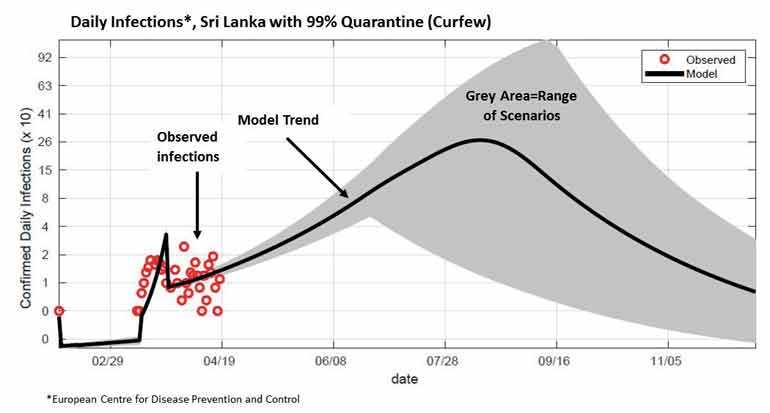Monday Dec 22, 2025
Monday Dec 22, 2025
Wednesday, 22 April 2020 03:15 - - {{hitsCtrl.values.hits}}

By M.V. Muhsin
Reporting from Washington DC
|
Professor Malik Magdon-Ismail
|
“Sri Lanka illustrates the classic Catch 22” with regard to COVID-19, says Professor Malik Magdon-Ismail, a Sri Lankan-born Computer Science Professor at Rensselaer Polytechnic Institute (Troy, NY) and an alumni of Caltech and Yale. He’s been in the news in New York media given his expertise in machine learning, data mining and pattern recognition
So far, the Government’s plan for easing the curfew is in line with Magdon-Ismail’s Catch 22 predicament. The Government’s plan to revive the economy and provide relief to the low income/vulnerable sectors
Ultimately, what authorities need to keep in mind is making sure the solution (shut down of the economy) is not worse than the problem initially posed
Professor Malik Magdon-Ismail has developed a models for several states in the badly-hit US that are sobering and alarming as was the case with New York with a population of 19 million – a few millions short of the Sri Lankan population.
In the case of Sri Lanka his model shows the number of coronavirus cases in Sri Lanka peaking around mid-August. He hopes he is wrong but the model has its own outlook. This is determined by assumptions on how many people stay home and how quickly serious cases climb.
Using these assumptions, the machine learning model extracts epidemiological properties of the pandemic by “robustly” accounting for known cases and population data, to project how the pandemic will evolve. This includes total infection count, number of asymptomatic cases, and projected peak for the pandemic.
Given the curfew in Sri Lanka, Magdon-Ismail factored a 99% quarantine into his model calculations. Visually, he illustrates infections with red dots, projections with a solid black line, and a range of possible trends in infections with the grey shading to represent the uncertainty of the virus spread (i.e. how the virus spreads, who it spreads to, effectiveness of the quarantine).
Using data from the European Centre for Disease Prevention and Control, the model estimates infections slightly increasing at about 3% per day. The model shows infection rate growing slowly and peaking at 270 per day with around 21,500 total infections at the peak. Without insight into whether systematic testing is occurring, Magdon-Ismail advises that the next few days will be telling to see if confirmed infections (red dots) are slowly increasing, or going down.
Referring to the Catch 22 that Sri Lanka is faced with, Magdon-Ismail explains: “The country has managed to strongly social distance and bring the rate down drastically. The curfew is working, but it has prolonged the process, extending the peak into August. If the curfew does not bring the infections down to zero before herd immunity (where majority of population is immune) has built up, it all just restarts.”
More data, given the sporadic nature of the current data available in Sri Lanka, will help inform the trend.
So, what should authorities do? And that is the big question. As leaders grapple with when and how to curtail the curfew, one important consideration is to determine how much stress the healthcare system can handle. Strategies such as a strictly imposed curfew allow the healthcare system to breathe, however, they prolong the country’s inability to function. Adjusting the lever to a point where the country can resume semi-normal function without overwhelming the healthcare system is key.
Magdon-Ismail is developing new tools that can be calibrated to help authorities achieve that delicate balance and systematically phase out social distancing measures such as curfew.
Ultimately, what authorities need to keep in mind is making sure the solution (shutdown of the economy) is not worse than the problem initially posed. So far, the Government’s plan for easing the curfew is in line with Magdon-Ismail’s Catch 22 predicament.
The Government’s plan to revive the economy and provide relief to the low income/vulnerable is essential. Let’s hope the balance beam being established will be well calibrated to ensure that all Lankans receive the healthcare needed as we endure this pandemic.
(Malik Magdon-Ismail, PhD, is a Professor of Computer Science at Rensselaer Polytechnic Institute, Troy, NY. He can be reached at [email protected])